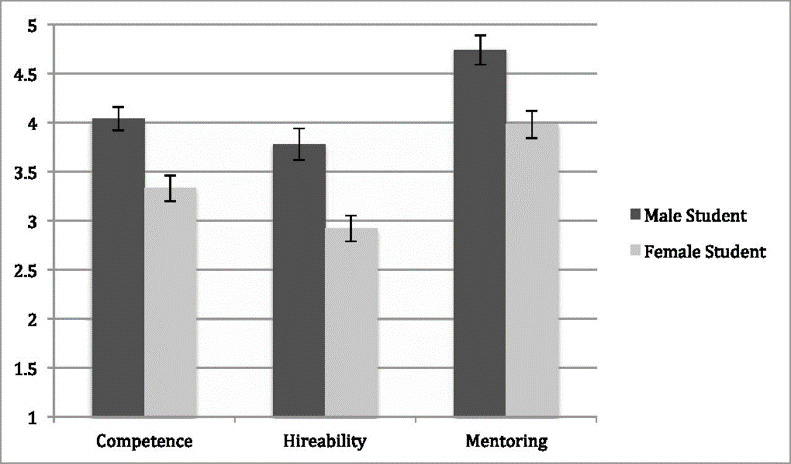 By Bronwyn Lyons, PhD Student, Strynadka Lab
By Bronwyn Lyons, PhD Student, Strynadka Lab
Dr. Donna Strickland – the first Canadian female scientist to win a Nobel Prize within the sciences categories1; the first female in over 50 years to win within Physics; only the third in its 107-year history; and one in the eye for Alessandro Strumia, a recently suspended scientist at CERN who stated at a presentation on gender and higher energy physics that ‘physics was invented and built by men’2. Prof. Strickland was awarded the Nobel Prize for her Doctoral thesis work on chirped pulse amplification, a methodology now used in corrective eye surgery and medical imaging1.

Figure 1: From Moss-Racusin et al. (2012); depicting differences in competence, hireability and mentoring of female student applicants5. Error bars are standard errors; nmale=63 and nfemale=64.
Unfortunately, the statistics of successful women in science are so bleak that a woman winning the Nobel prize in a science category is big news. The leaky pipeline of science refers to the drastic drop-off of female scientists from academia between post-doctoral fellowships and academic positions3,4, despite the roughly equivalent representation of women and men earning PhDs in a STEM-related field. Why are women underrepresented in academia despite steps being taken towards inclusion and equality?
A contributing factor may be that women put their careers on hold to raise children; however, in today’s modern society, this is not necessarily the case. A shocking study published in PNAS by Moss-Racusin et al. (2012) explored gender bias during the hiring process5: The applicants were all undergraduate level students, which authors considered a critical time in a young scientist’s career. Interviewers (professors across biology, chemistry and physics) were assigned an application package for a laboratory manager position that was labelled with a name randomly identifiable as either male or female, with the only variable between the applications being the gender. Interviewers were asked to rate the applicants on whether they would be hired, receive mentorship, their competence, and provide a starting salary, with the knowledge that the applicant would receive this feedback. Female applicants were deemed less competent, less hireable, provided a lower starting salary and offered less mentorship (Figure 1). Both female and male professors, regardless of age, field of study and tenure status, equally viewed female applicants as being less qualified than the equivalent male applicant. The authors concluded that being viewed in this manner could lead to a withdrawal of females from a future academic career5. A similar study revealed that women are directly excluded from influential laboratories: Male faculty who were funded by large granting agencies or had won a major award, hired fewer female graduate students and post-doctoral fellows in their laboratories6.
Young researchers need to see that there are strong female-identifying scientists out there, role models like Dr. Donna Strickland, to perceive themselves capable of pursuing their dreams and pushing for cutting edge discoveries in STEM research. So, how do we know when we have reached equality between genders in the sciences and ‘plugged’ the so-called leaky pipeline? Perhaps we’ll know we’re headed in the right direction when the headlines stop reading ‘Female Scientist Wins Nobel Prize’ in future award seasons.
- https://www.theglobeandmail.com/world/article-canadian-scientist-donna-strickland-shares-nobel-physics-prize/
- https://www.bbc.com/news/world-europe-45709205
- Ceci S., Williams W. (2011) Understanding current causes of women’s underrepresentation in science. P.N.A.S. 108:3157-62
- Gumpertz M., Durodoye R., Griffith E., and Wilson A. (2017) Retention and promotion of women and underrepresented minority faculty in science and engineering at four large land grant institutions. PLoS One. 12: e0187285.
- Moss-Racusin C., Dovidio J., Brescoll V., Graham M., and Handelsman J. (2012) Science faculty’s subtle gender biases favour male students. P.N.A.S. 109:16474-9
- Sheltzer J. and Smith J. (2014) Elite male faculty in the life sciences employ fewer women.


